Twin-Fin Experimentalist Torren Martyn Talks About His Year-Long Surf Adventure by Sailboat
The Byron Bay native opens up about learning how to navigate, searching for swell by boat and nearly sinking in the middle of the night
Byron Bay native and stylish twin-finner Torren Martyn is accustomed to traveling around the world in tight spaces. In 2016, he and his filmer/best mate Ishka Folkwell loaded up a red 1987 Land Rover Defender and spent three months circumnavigating Australia in search of waves. In 2018, the duo took another wave-hunting three months to zigzag around New Zealand's coast on motorbikes. And a year later, they bought a 2008 Ford Transit in Europe that they slept in while shredding all the way from Ireland down through the west coast of Africa.
Last year, Martyn embarked on yet another feral surf hunt–this time by sailboat. In March of 2022, Martyn and his partner Aiyana Powell purchased a 1982 35-foot Endurance sailboat named Calypte in Thailand and spent an entire year cruising down to (and throughout) Indonesia, posting up at world-class waves–sometimes without another soul in sight.
But, as Martyn explains it, the journey wasn't always as romantic as it sounds. We called up Martyn a year and some change after he first set sail on his epic adventure to hear about the ups (scoring perfect reefbreaks alone), the downs (almost sinking the boat in the middle of the night), and the memorable in-betweens.
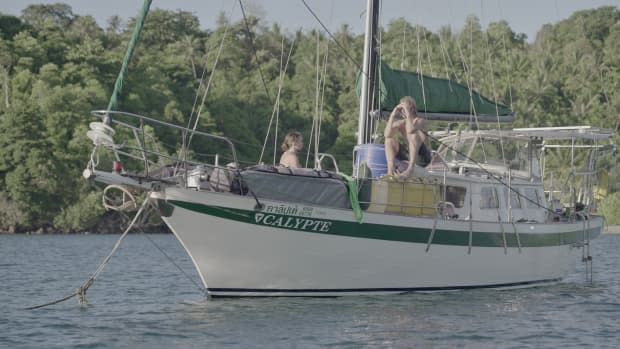
Ishka Folkwell
So you and Ishka have obviously traveled all over the world to search for surf by plane, van, car, or bike—when did you get the idea to travel by sailboat?
When Aiyana and I met, it was this dream that she and I had shared. Aiyana had grown up on a boat for the first 10 years of her life and I really wanted to get into sailing but neither of us had any kind of experience. We really just jumped into the deep end with it all. Obviously, the idea of making a film around it in conjunction with needessentials [Torren's main sponsor] was pretty natural as that’s what Ishka and I have been doing for a few years now.
We ended up spending a year on the boat, basically learning to sail through southeast Asia, north Indonesia across Sumatra, and down the west coast of Indonesia. All in all, it was over about 5000 miles or so.
Why did you go to Thailand to get it?
My dad has had the boat for the past 14 years. He had it on the market at the same time Aiyana and I were looking at buying a boat. He basically gave us the opportunity to move the boat closer to Australia for him and if we liked it, we could buy it from him if we wanted to and keep going. It was too good to say 'no' to.
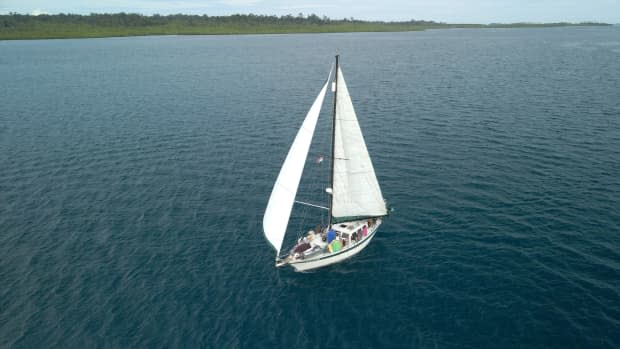
Ishka Folkwell
Did you do any prep work to figure out how to sail or did you literally just fly to Thailand and start learning on the spot?
For about six months leading up to our departure, we spent a little bit of time on some of our friends’ boats, but our time was limited in the local river and one half-day sailing in the ocean. We picked up some learn-to-sail books and were quizzing each other on all the lingo and the terminology. I signed up for a course when I was back in Australia but the only two units I completed were “How to Deploy a Life Raft” and “Identifying Fires and How to Put Them Out” [laughs].
Other than that we went in pretty blind at the start of the trip. Luckily we had people join us for the first six-to-eight weeks of the journey who we could lean on and learn from. They helped us through a couple of thousand miles into the Indian Ocean. It was a really good opportunity to iron out things with the boat because the boat hadn’t been used for like three years.
Who all stayed with you?
George–a mechanic who has lived on the ocean sailing for the last 20 years–was with us for the first two weeks of the trip, which was about 700 or 800 miles. That was from the Gulf of Thailand up near Bankgok, down past Cambodia through the South China Sea, and around Singapore. George left us there and then a new mate named Kelly Foote joined us. Kelly was with us for four weeks from Malaysia, up the Malacca Straight, and around the north of Banda Acehae, and through to some of the islands off Sumatra. Then our friend Ryan was with us for a couple of weeks. Those first couple of months were really busy and intense. We learned a lot in that short time [laughs].
Did you run into any issues while you were learning?
In the first couple of weeks, we had what could have been a catastrophic thing happen to us. If George wasn’t on board it would have been a lot worse. We were about 10 miles off the coast of Malaysia in the South China Sea and basically, this little hose clamp broke. All the water that was coming in through the intake to cool the engine, which normally goes out through the exhaust out the stern of the boat, was going straight into the bilge so it was basically sinking itself. And it wasn’t until we checked the bilge, that we could see the water levels were coming up and about to swamp the battery and the engine. At the time we didn't know where the leak was coming from or what to do. George was there and he basically kept his cool when we were kind of freaking out. He was able to make a couple of decisions and we were able to diagnose the problem before it got much worse.
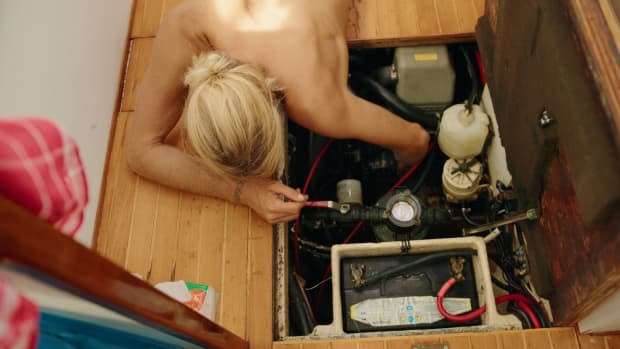
Milo Inglis
Did you think for a second you were going down?
For sure, yeah. I always go to the worst case [laughs].
Was that a wake-up call for you in terms of how much you had to learn before you were on your own?
Yeah, I mean, there are just so many moving parts and so much to learn–from simple navigation to learning how to sail, learning the boat, reading the weather, and even little things like anchoring. There was nothing we didn’t already know [laughs]. We didn’t even know if we were going to be able to live on a boat. We didn’t know if we were going to get sick or if we were going to enjoy it. It was a huge adjustment to the body and the mind—even the way time passes, everything changes. You’re incredibly isolated and, without experience, you’re incredibly vulnerable as well. But our experience grew over time. The first storm felt like the scariest thing in the world but looking back it was really mellow.
Run into any issues on your own?
Yeah, we were making one of our first passages between islands at night. It was just after midnight and I was on watch—we were doing three-hour shifts each. I did a routine check under the bilge and I look in there and the engine is about to get swamped by seawater. When I saw that my heart jumped out of my chest and I was like, “We’re going down.” I could hear it gurgling under the engine. We were 30 miles from land, it was pitch black, just the worse possible case. I woke Aiyana up in a full fluster.
In that moment I just felt like such an idiot that I did not know what was going on, I didn’t know how to fix it. We decided to turn around–which was a big decision. Heading back we were heeled over on the opposite side of the boat naturally and the water that was coming in was significantly less and we were able to manage it. We could basically pump water out of the boat and it was coming in a lot slower. At that point, we kind of realized everything would be okay but still completely baffled at what was happening. We got back into the little bay at Lagundri on Nias at sunrise and we basically learned that there’s a little valve in the bilge pump that water was coming back in through.
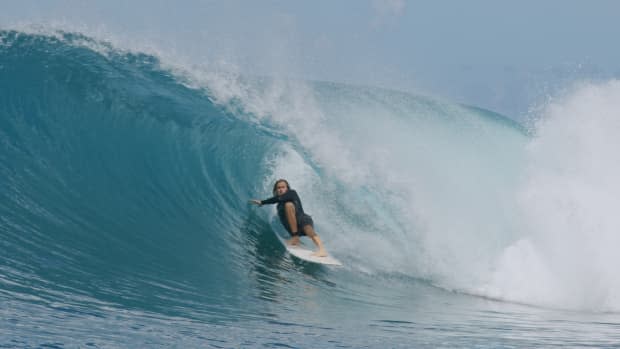
It was one of those lessons that you’re never going to know what’s going to go wrong and you’re never going to be able to diagnose something straight away. It’s more just knowing that everything most likely is going to be okay.
In terms of surfing, do you feel like traveling by sailboat gave you better access to waves you had never been to before?
Certainly, in a way. Traveling by sailboat is amazing because it can take you to all these really remote places, but it takes a lot for everything to come together. People say sailing and surfing go hand in hand but it’s kind of the opposite [laughs]. Sailing is tricky because you have to be quite calculated. You need an anchorage that has good holding, a place you’re protected from swell and wind—but with surfing, you kind of want a spot that’s unprotected from swell, that’s getting as much swell as possible, that has reef and you want the wind to be offshore.
Indonesia is full of world-class waves. It’s probably the most wave-rich place in the world for surfing. That really gave us more options than if we were anywhere else, but still, it can be quite rare for the elements to come together and to be in the right place at the right time. We had a pretty rough year weather-wise. We’d go through phases where we’d surf our brains out for a couple of days and then not surf for weeks. We’d be locked in a bay when the weather was hitting for a week or we’d have maintenance to do on the boat.
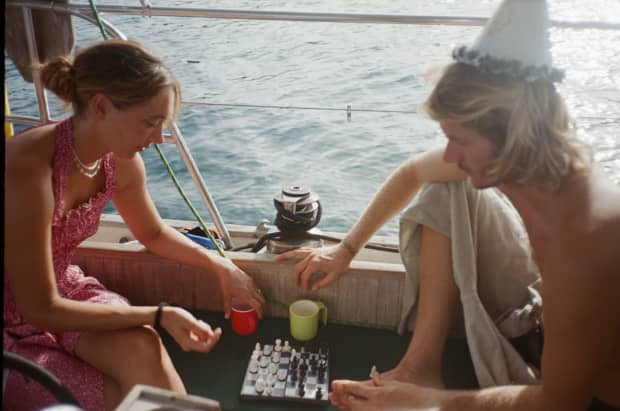
Kelly Foote
The idea of sailing from perfect wave to perfect wave seems like a fantasy, but I guess it’s not always that cut and dry.
I mean there were a lot of perfect waves, too. One of the first weeks we finally made it to waves, when we finally came around the corner in the Banyaks, we rolled up to this tiny deserted island with no one living on it and there was a glassy, perfect four-foot right just peeling with absolutely no one in sight. That was just like a holy-shit-we-made-it moment. Dropping the anchor and paddling into the lineup from the boat was so incredible.
A few weeks later we had a proper swell at a wave that I had heard whispers of, but it was more or less a no-named wave and it was one of the best days of surfing of my life. And it was just me and a mate in the water with no one around. Sitting in the water that day, surfing and looking back at the boat I felt like my life was complete.
Were most of the waves you surfed only accessible by boat?
Yeah, pretty much most of them. On the boat, you have everything you need to survive. You’ve got food and water to last you weeks or months, and first aid supplies to get you out of any kind of trouble. You’ve got your little home there. We didn’t spend a lot of time on land. We always needed to be near the boat for when conditions changed. Any time we’d leave the boat and it was out of our sight, we’d be thinking and worrying about it.
Do you feel like you were more on alert than if you were just on a standard surf trip?
I was for sure—I was a stress case. I was probably not that fun to be around [laughs].
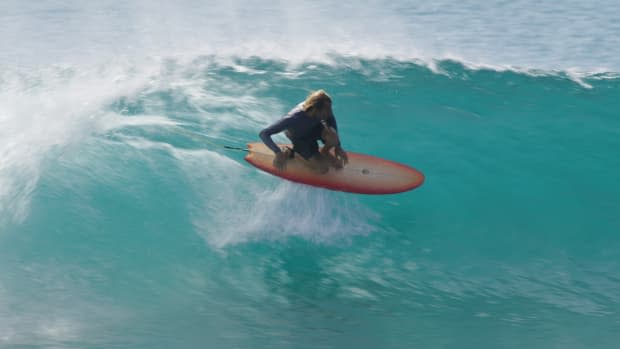
Milo Inglis
And you’re normally a really chill person.
I was really on edge. I don’t think I got a full night's sleep the whole year. There are a few shots in the film that I look at now and I look like a totally different person–10 years older than I am [laughs]. I felt good and I was loving it but there was just always something to think about. I could never really relax and that was because I went into it completely inexperienced, and with a lot of weight that I put on my shoulders, needing to be responsible for everything. Even after a year of living on that boat, I still feel like I’m such a rookie and that I don’t know enough. I learned so much but there’s also so much more to learn.
But on our next boat, I’d have a totally different approach. Now that the scales have kind of changed, we know what we’re capable of and we know what the boat is capable of.
Your next boat?
We are going to go check out a boat down in Guatemala–which is actually the boat that Aiyana grew up on. Her family ran out of money when they were traveling and they’ve been keeping it down in Guatemala for the past 14 years. There were only 12 of them made in the world and it’s a beautiful, old, safe boat but it needs a lot of work. We’re just going down there to do a bit of recon. We’ll go down there, get some photos and videos and start the conversation going for the next trip.
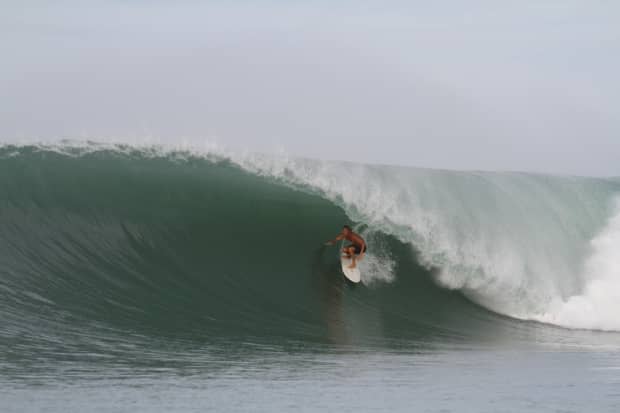
Adrian Wau
